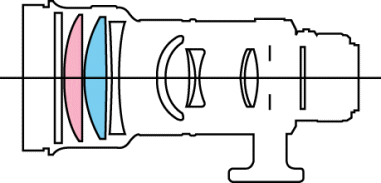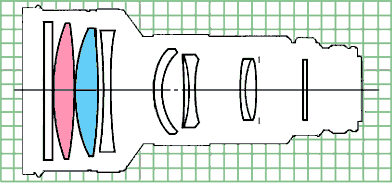My story with and thoughts on this L lens.

Technical details
Mount: nFD
Aperture: f2.8-32, 9 blades
Min. focus distance: 3m - 1:9.1 magnification
Lens design: 7 groups, 9 elements
(1 protective glass, 1 Fluorite glass and 1 Ultra-low Dispersion glass/UD)
Weight: 2310g
Year of introduction: 1981
Other versions:
1:FD 300mm f/2.8 S.S.C. Florite (1975-1981)
2:EF 300mm f/2.8 L (1987-1999) and later EF versions.
How I met this lens:
I remember how low my jaw dropped when my friend shown me portraits taken with his modern Nikkor 300mm f2.8 lens. The compression. The bokeh. The sharpness. It is so unique. I secretly promised myself - I will get a 300mm f2.8 lens! But after checking how much such lens may cost, my jaw dropped even lower.... I will never be able to afford a 300mm f2.8 lens!

One of my favourite shots with this lens is actually a landscape shot.
But things will find their ways into your life if you want them hard enough, I suppose.
Not long after I reset my jaw, I saw a post in a vintage lens group on facebook, someone wanted to sell out his FD lens collection. Reading through the list, I saw - FD 300mm f2.8 L - Defected.
The lens has a built-in lens hood and another add-on hood (Model EH-123), which can be mounted reversely when in storage.

The signature Canon red ring and its L series started with FD lenses.
FD lenses are pure mechanical lenses Canon produced from 1971 to 1992, before its electronic lenses (EF lenses). L (Luxury) series lenses are the very best lenses produced from Canon post-1979 onward. I had been using another L lens - FD 80-200mm f4 for some time (Review on this amazing lens is on my to-do list). It is such an amazing and very well built lenses. I love using it very much. So I quickly set up a meeting with the seller, and prayed to the Canon god that the condition of the lens was not too bad.
24 hours later, a very decent gentleman in his early 50s was sitting across the coffee table and showing me this "defected" lens. "Some of the glasses have haze", he said. "You will need to bring it to a technician to clean it out. This will cost much money. That's why I am selling it cheap." What a considerate and honest man, I think. (This generous gentleman later ended up helping me with other things as well. I am really thankful to him.)
I carefully put the lens onto my camera (my good Canon god, it's so heavy!), looked through it (so bright, so dreamy, yet so sharp! It reminded me the feelings I had the very first time looking through the Takumar 50mm f1.4 lens (Story and review of here.) The lens worked just fine even with the haze. I wondered how much better it would get when it's cleaned. Years later, after gaining experience disassembling other vintage lenses and having some wine, I ended up taking this lens apart and cleaned the haze myself. You can find out how on my other post here.

This "defected" lens then served me well for many projects. Although it is very heavy to carry around, I never hesitated to bring it with me, even to overseas projects. The helpful reach of a 300mm lens, and the fast 2.8 aperture opened up a lot more artistic freedoms and possibilities for me. On top of that, the sharpness of this lens throughout the focus range is remarkable. It is even sharper than many good 50mm lenses.
1:Lens hood, lens body with Canon 1.4x-A extender;
2:Lens elements are all coated with S.S.C.;
3:Side view.
Review

Bokeh
300mm. F2.8. And a L. As one might expect - very smooth and creamy. Bokehlicious. It has 9 blades. So bokeh stays relatively round throughout the aperture range.

Ergonomics and Build
It has an internal focus design, which means the physical size of the lens does not change during focus, nor does the front of the lens rotate. It makes the lens easier to use by maintaining the weight balance between the lens and camera.
Focus throw is about 260 degrees. This thick lens takes some (smooth) turnings to focus from infinity to the minimum focus distance - 3 meters. Given both very narrow angle of view and depth of view, one may get lost while tracking subjects and manual focusing.
It has a "focus preset" mechanism (1st photo below). After tightening the notch at a desired focus distance, it then become the maximum focus distance. The focus ring would not turn past beyond it. I suppose, it would be useful when you expect a subject to appear at a certain focus distance, for example the goal in a Football game.
There is also a button (one-touch revolving mechanism) on the built-in tripod mount ring (2nd photo below). One could easily turn the lens to landscape or portrait orientation when it is mounted on a monopod/tripod.
At the end of the lens, there is a slot for 48mm screw-in filters (3rd photo below). It also serves as a protective glass for the aperture.
The all-metal construction is very robust. The lens alone weights 2.31kg(!), which is very heavy. It is difficult to focus while holding it with only one hand. One obvious solution is simply going to the gym more often, the other is to use the lens on a monopod, which gives stability (essential for a 300mm lens) as well as mobility.
Image Quality and Chromatic Aberration
This is a very sharp lens. Thanks to the artificial crystal Fluorite and Ultra-low Dispersion (UD) glasses, images taken at f2.8 are already very sharp and with the beautiful signature Canon color at both infinity and at the minimum focus distance. And I repeat, it is even sharper than many good 50mm lenses.
Color fringes are very well controlled. When shooting wide open in harsh environment, fringes are noticeable but not distracting. Stopping it down to f4, the image becomes even sharper and fringes start to disappear. From f5.6 onward, there is nothing to worry about.

Flare and Ghosting
Canon's Super Spectra Coating (S.S.C.) does a fantastic job. The two bulky lens hoods of course help a lot. Always keep them on. Basically they hide the lens and the caveman behind into a cave. The lens does not ghost and flare much under normal situations. Although contrast drops significantly under harsh light, it is forgivable given the enormous front element with a diameter of 11.5cm. And, hey, contrast is easily adjustable in post processing.

Distortion
There is no observable distortion. Very well controlled.

Ok it's a great lens, but does one really need the f2.8?
There are many other good 300mm f4 or f5.6 options. They are much lighter, easier to carry and use. But since the image quality of this lens at f2.8 is already so good, I have no hesitation to use it wide open. Even with in-camera stabilisation and outstanding high ISO performances on modern cameras, it is still difficult to shot with a 300mm lens in low light situations. The f2.8 stop proved to be really helpful and sometimes crucial. One more advantage of having the f2.8 is that, you could add an extender and still have enough light for shooting. (More on extenders and FD 1.4x-A extender review here)
So I would say, yes I really need the extra f2.8.
No stabilisation. No auto focus. Heavy. Still appealing nowadays?
It takes practice to get used to focus manually, and on such a heavy long lens, honestly, it becomes even more challenging. If you need high focus speed like for shooting sports and birds, of course this lens is a No-No. I am used to manual focus lenses, and I use it mainly for concerts/events where people move not so quickly. So the lack of auto focus doesn't bother me much.
Most camera nowadays have in-camera stabilisation. And usually you would use a 300mm lens on a monopod/tripod, unless you have very strong and steady arms. So I don't think stabilisation in a 300mm lens is crucial.
Having no electronic components inside is actually one of the things I like about this lens. Since it is so well-built, it does not require as much care as an electronic lens. Sometimes I would just carry it naked in my backpack. If it had electronic components, I wouldn't have brought it out as often.
True, it is heavy (2310g). But because of the auto focus and stabilisation mechanisms, the later Canon 300mm f2.8 lenses are much heavier: EF 300/2.8L - 2855g; EF 300/2.8IS - 2550g; EF 300/2.8IS II - 2350g. Nikon's 300mm f2.8 lens from the same era weights 2500g. There are other (not much) lighter but far less good options, for example, the older version FD 300mm f2.8 Fluorite lens (1900g), and Tamron Adaptall-2 SP 300mm f2.8 LD IF 60B (2096g). Weight is the price for having f2.8 and supreme image quality.
One interesting thing:
The diagram of EF 300mm f2.8 L (1987-1999) (left) looks very similar to the FD L diagram (right). Since the flange focal distance of the FD L lens is already quite long, it makes sense that Canon might have used the same optics formula, added a focus mechanism and changed the mount to make it into the first EF 300mm f2.8 L lens.

Landscape photos taken with this lens are really special. Ok, I cheated, this photo was taken from my air-conditioned hotel room. I didn't climb mountains with it......
This canon opens up so much more artistic freedoms and possibilities.
Informative websites:




















